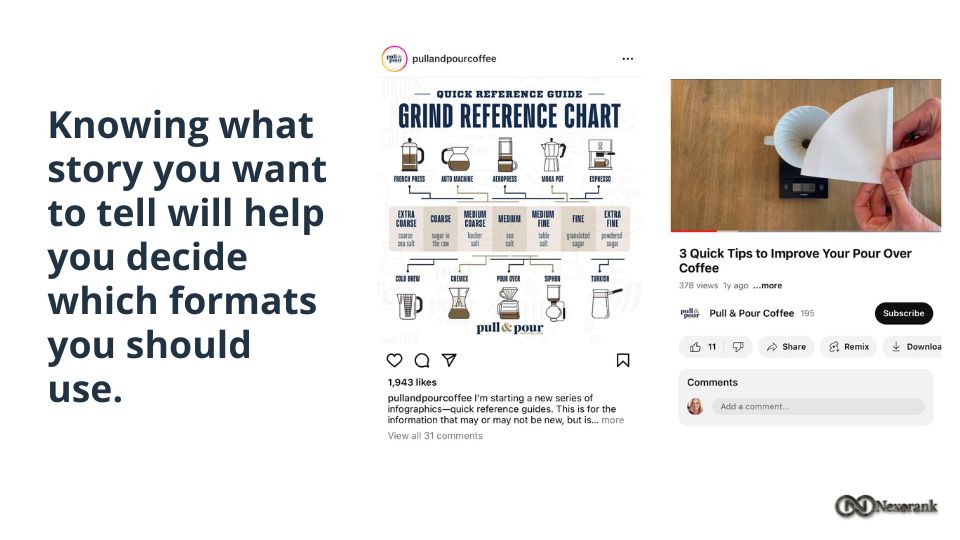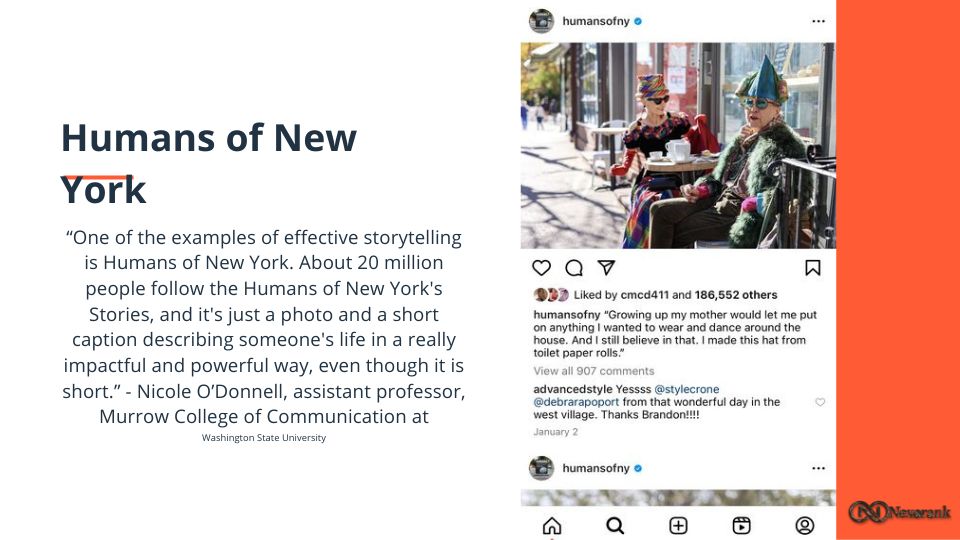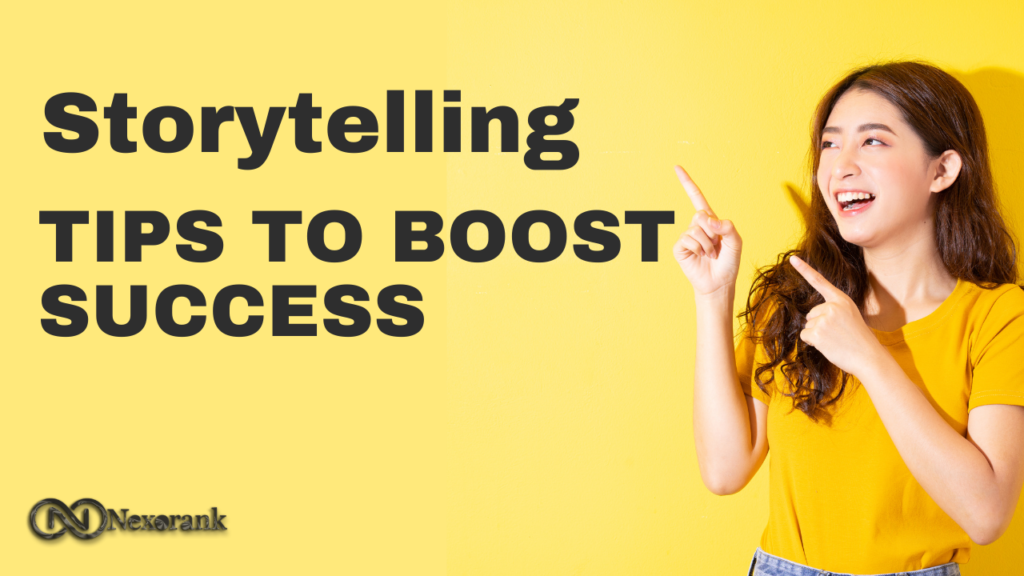Storytelling has always been an e ective way to connect with an audience, but on social media, it’s become essential. Social media users are constantly scrolling through their feeds, looking for content that captures their attention and resonates with them. As a marketer, it’s your job to create that content, and storytelling is one of the best ways to do it. From crafting the perfect Instagram post to producing a captivating video, storytelling can help you make an impact on social media.

But where do you start? Let’s explore some tips and tricks to think about the stories you want to tell to captivate your audience.
First, you’ll want to keep in mind that di erent platforms require di erent kinds of content, and certain types of content perform better than others. Knowing what story you want to tell will help you decide what formats you should use. Some complex stories might be best told with an infographic, while others may be better told with a long-form video, and a quick call-to-action might only need a photo to draw people in. Once you determine the structure of your story, you’ll have a better idea of how to use the various formats and which platforms to use.
Shakespeare, in Hamlet, tells us that “brevity is the soul of wit.” It’s also the soul of social media, which is a haven for short and sweet stories. Here’s Nicole O’Donnell, assistant professor, Murrow College of Communication at Washington State University to share more.

Nicole O’Donell: Attention spans are incredibly short these days. I believe it was a study by Facebook that showed that we are now scrolling through 300 feet of content on mobile devices every single day. And that’s about the length of the Statue of Liberty. So it takes a lot to cut through that noise, and I think stories are one way that we can do that. One of the examples of e ective storytelling is Humans of New York. About 20 million people follow the Humans of New York’s stories, and it’s just a photo and a short caption describing someone’s life in a really impactful and powerful way, even though it’s short.
Now that you understand why it’s important to know the story you want to tell, let’s talk about some storytelling do’s and don’ts.
First, don’t use jargon or business speak. Instead, use visuals to show your ideas. According to the Visual Teaching Alliance , visuals transmit information faster than spoken or written words. In fact, we can get the sense of a visual scene in less than 1/10 of a second, and visuals are processed 60,000 times faster in the brain than text. Don’t focus too much on yourself or your brand either, but do know your audience. For example, if they’re expecting product demonstrations, then the need to tell a story may not be as necessary.
Remember not to leave plot holes by making sure to outline your plot and core message. This will give cohesiveness to your story and keep your audience interested. And make sure your characters aren’t too perfect. It’s better to be realistic and honest instead. Social media trends toward authenticity today — audiences want to hear truth from real people. With storytelling, don’t skim over the details; connect with your audience by going deep. This also helps you di erentiate your story from that of your competitors.
Be careful when it comes to your call-to-action by not selling it too hard. Instead, make it useful. Let your audience know how you’ll help them. And finally, don’t overcomplicate the story — it’s best to leave room for imagination. The best stories are those that allow the reader to feel like they’re connected, and in that regard, imagination is key.
These do’s and don’ts can be applied to all types of stories. Here are some you may apply them to and consider telling:
- ●Customer testimonials: Share real-life stories from satisfied customers to showcase the benefits of your product or service.
- ●Product demos: Showcase how your product or service solves a problem or addresses a need.
- ●Company culture: Share stories about your company culture, employee experiences, and company values.
Here’s Jenny Li Fowler, social media director at MIT with more.
Jenny Li Fowler: Acampaign that we had at MIT that really centered around visual storytelling was our “This is MIT” campaign that was really driven by our students. So, MIT has this perception that we’re all work and no play. But with this campaign, we really wanted to showcase the creative side of our students and just the amazing talents they had outside of the classroom. So we ran a competition where they would create a video and submit it for a prize at the end of the year. We wanted them to focus on something they did in addition to their studies and what they did outside of the classroom. And yeah, Imean, the talent and just the creativity of our students – who better to tell their story than the students themselves? It was just wildly successful, and to this day we still use the hashtag #ThisIsMIT. So it was a win!
- ●Thought leadership: Share industry insights and thought leadership pieces that tell astory and position your company as an expert in the field.
- ●Brand campaigns: Create a narrative around your brand and communicate its history, products, values and mission.
- ●Industry events coverage: Share stories about the events you host or attend.
- ●Behind-the-scenes: Give a behind-the-scenes look at the company, such as how products are made or how decisions are made.
- ●Collaboration and partnership: Showcase the company’s work with other businesses, organizations, or influencers.
- ●Corporate social responsibility: Highlight the company’s corporate social responsibility initiatives, such as its e orts to promote sustainability or support the community.
- ●Humorous or entertaining: Be funny or entertaining to help build brand awareness and loyalty.
As you can see, there are a lot of options, so you may want to choose a few specific themes to work with as you develop your content calendar. If you need a refresher on how to develop your overall content strategy, check the resources section for a link to the Building a Content Strategy for Social Media lesson from the first social media certification course.
Let’s close out with one last tip from Nicole O’Donnell:
The final tip that I have for marketers is to try to transport your audience into an experience. Have them want to be involved in the story. In psychology, we have the concept of narrative transportation in which the audience is emotionally engaged with the story, and I think that’s one of the most important concepts for us to think about when we are creating storified content.



















